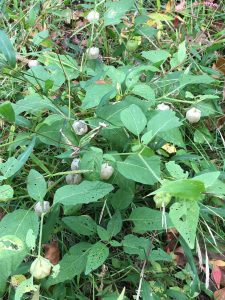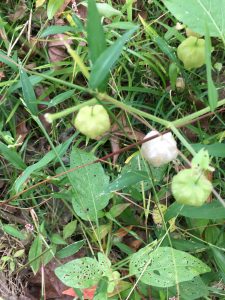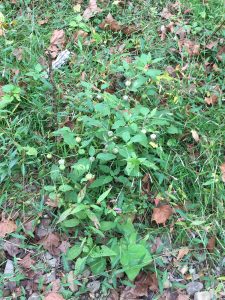
On Sunday October 13, I did my third sit-spot from 2:17pm-3:33pm. The organism that I decided to study was a green plant that was relatively short (approximately 1 foot tall) with green leaves that are pretty thin and long. The leaves come to points at their tips and have visible veins that run out to the edges of the leaves from their centers. I also observed that the leaves have many holes all over them, meaning that they are a food source for other organisms. However, I did not see any organisms eating the leaves during my observation period. The plants are growing in a cluster near the creek. They are growing among the grasses that are abundant just before the platform of rocks that sits above the creek water.

I noticed green, round parts of the plant that are attached by stems and hang down from the plants. They swing back and forth in the breeze. A lot of them are green, but I have observed that each time I do my sit-spot blog, more and more of the round parts of the plant have turned white with tiny holes all over that make them almost clear. They look like they are made of cheese cloth. While the leaves of the plant are dull, the round parts of the plant are slightly shiny. They are not perfectly round. They are wrinkled and have veins running through them that make them bumpy. They come to a point at the bottom.
I was excited to find out more about this plant because I have wondered what it is each time that I have done my sit-spot. After observing the plant, I was able to easily find out the name of the species by uploading an image of the plant to an online app that instantly showed me what the plant was. I then confirmed it with a quick google search. The plant is a Long-leaf Ground Cherry (Physalis longifolia). It is a perennial plant, which means that its life cycle lasts for more than one year. Long-leaf Ground Cherries are native to many parts of the US and the plants’ blooming seasons are July-September, which means that they are at the very end of their season. Long-leaf Ground Cherries range in height from 12 inches to 40 inches, so the ones that I saw are on the shorter side. The round parts of the plants that I observed are the calyx, which inflates when the flowers are fertile. The calyx contains the fruit of the plant, which is a green berry that turns yellow when ripe. When the fruit is ripe, the calyx changes color as well, which explains why I have noticed the color change over time. The white calyx with many holes is probably that way because the fruit is now overripe.
 Another name for the species is “husk-tomato” because the small fruit apparently tastes similar to a tomato and the calyx is similar to a husk. These plants are able to form colonies by spreading their rhizomes, which are horizontal stems that grow underground. This root system enables these plants to be invasive in different environments and must be how the plants by the creek are growing in clusters. Because these plants are members of the Nightshade family, they are of interest for medical purposes, especially cancer research.
Another name for the species is “husk-tomato” because the small fruit apparently tastes similar to a tomato and the calyx is similar to a husk. These plants are able to form colonies by spreading their rhizomes, which are horizontal stems that grow underground. This root system enables these plants to be invasive in different environments and must be how the plants by the creek are growing in clusters. Because these plants are members of the Nightshade family, they are of interest for medical purposes, especially cancer research.
Overall, I really enjoyed doing this sit-spot. It was interesting to focus on just one particular organism and find out more information about it. This exercise has made me want to discover more about plants that are unfamiliar to me.
References Cited
Physalis longifolia (Long-leaf Ground Cherry). Minnesota wildflowers. Retrieved from
https://www.minnesotawildflowers.info/flower/long-leaf-ground-cherry
Longleaf Ground Cherry (Wild Tomatillo). The friends of the wild flower garden, inc. Retrieved
from https://www.friendsofthewildflowergarden.org/pages/plants/groundcherry_longleaf.html


I had no idea this plant had medical applications, that’s awesome!